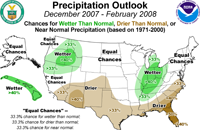NOAA Reports U.S. Likely to Have Above-Average Winter Temperatures
La Niña Arrives, Southern Drought Concerns Intensify
October 9, 2007

U.S. Temperature Outlook, December 2007 - February 2008.
+ High Resolution (Credit: NOAA)
NOAA forecasters are calling for above-average temperatures over most of the country and a continuation of drier-than-average conditions across already drought-stricken parts of the Southwest and Southeast in its winter outlook for the United States, announced at the 2007-2008 Winter Fuels Outlook Conference in Washington, D.C., today.
“La Niña is here, with a weak-to-moderate event likely to persist through the winter,” said Michael Halpert, head of forecast operations and acting deputy director of NOAA’s Climate Prediction Center. “The big concern this winter may be the persistence of drought across large parts of the already parched South. And while December through February is likely to be another milder-than-average winter for much of the country, people should still expect some bouts of winter weather.”
For the 2007-2008 U.S. winter, from December through February, NOAA seasonal forecasters predict:

Sea surface temperatures, January 1, 2007 - October 3, 2007.
+ Download as Quicktime (Credit: NOAA)
- In the Northeast and the Mid-Atlantic,temperatures are expected to be above average in response to the long-term warming trend. Snowfall for the region will depend on other climate factors, which are difficult to anticipate more than one-to-two weeks in advance.
- The drought-plagued Southeast is likely to remain drier-than-average due to La Niña, while temperatures are expected to be above average.
- In the Great Lakes and Tennessee Valley, temperatures and precipitation should be above average.
- The south-central Plains should see drier-than-average conditions and warmer-than-average temperatures. Above-average temperatures are also expected in the central Plains. The northern Plains has equal chances of above-, near-, or below-average temperature and precipitation.
- In the Northwest, there are equal chances for above-, near-, or below-average temperatures. Precipitation should be above average in much of the region due to La Niña.
- Drought conditions are expected to persist in the Southwest due to La Niña, and temperatures are likely to be above average.
- Northern Alaska is expect to be milder–than-average, while the rest of Alaska has equal chances of above-, near-, or below-average temperatures and precipitation. In Hawaii, temperatures and precipitation are expected to be above average.

U.S. Precipitation Outlook, December 2007 - February 2008.
+ High Resolution (Credit: NOAA)
This winter is predicted to be warmer than the 30-year norm. For the country as a whole, NOAA's heating degree day forecast for December through February projects a 2.8 percent warmer winter than the 30-year normal, but a 1.3 percent cooler winter than last year.
The U.S. winter outlook is produced by a team of scientists at the Climate Prediction Center in association with NOAA-funded partners. Scientists base this forecast on long-term climate trends and a variety of forecast tools from statistical techniques to extremely complex dynamical ocean-atmosphere coupled models and composites. The outlook will be updated on Oct. 18 and again on Nov. 15 at 8:30 a.m. Eastern Time.
NOAA is dedicated to enhancing economic security and national safety through the prediction and research of weather and climate-related events and information service delivery for transportation, and by providing environmental stewardship of our nation's coastal and marine resources. Through the emerging Global Earth Observation System of Systems (GEOSS). NOAA is working with its federal partners, more than 70 countries and the European Commission to develop a global monitoring network that is as integrated as the planet it observes, predicts and protects.
